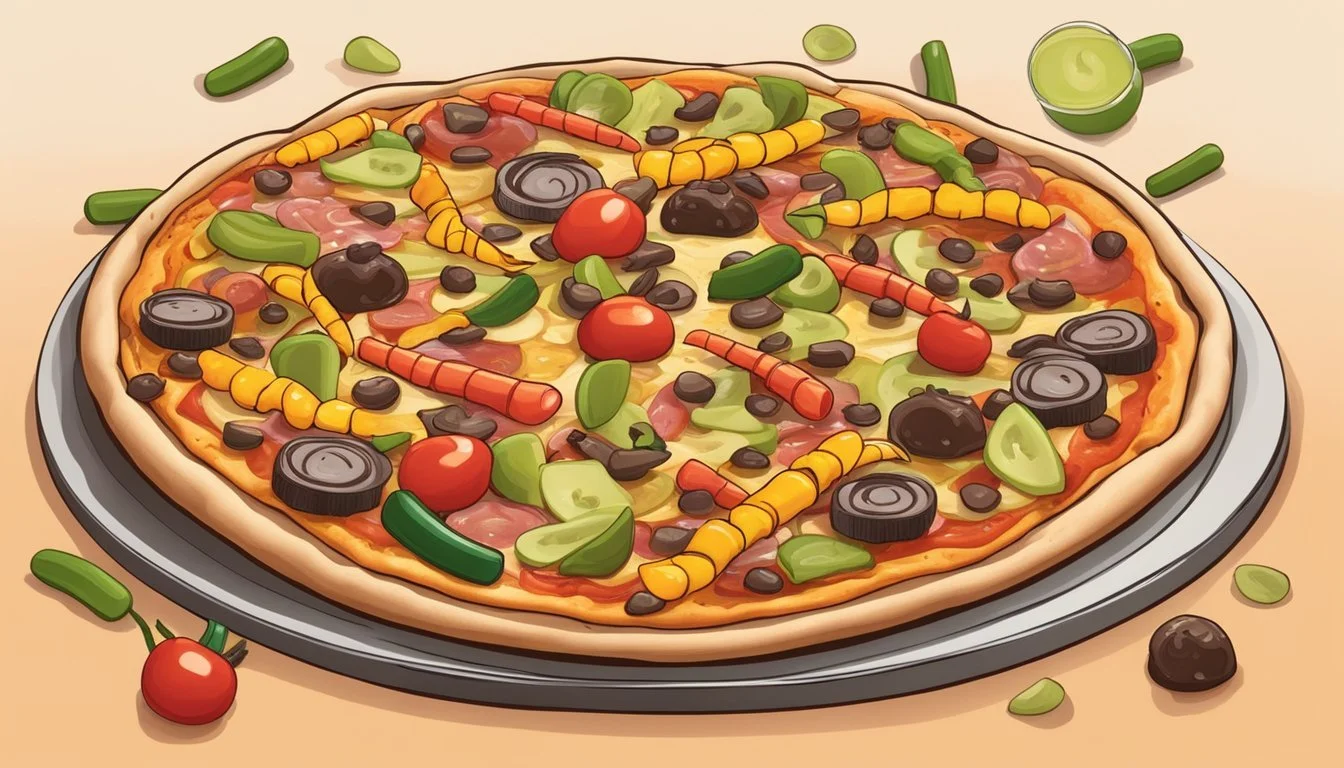10 Weirdest Pizza Toppings
Unusual Flavors You Must Try
Pizza, a beloved culinary delight, has evolved remarkably across cultures, leading to a plethora of unique and sometimes unexpected toppings. While traditional ingredients like pepperoni, mushrooms, and mozzarella reign supreme in many regions, some innovative minds around the globe have pushed the boundaries of what can adorn a slice.
For those adventurous eaters continually seeking new gastronomic experiences, exploring the oddest pizza toppings can be both a delight and a curiosity. From unconventional seafood choices to sweet and savory combinations, these toppings reflect regional preferences and creativity, offering a taste of local flavor and personality.
1) Marshmallows
Marshmallows on pizza can be quite a surprise for many. Originating mostly from dessert pizzas, this topping has found fans for its unique texture and sweetness.
The combination of gooey marshmallows with the crispy pizza crust creates an interesting contrast. When baked, marshmallows melt slightly, becoming soft and sticky, which pairs well with ingredients like chocolate or fruit.
This unconventional topping is often featured on dessert pizzas instead of traditional tomato-based versions. Popular pairings include chocolate and graham crackers, mimicking the flavor of s'mores, but on a pizza.
While marshmallow-topped pizzas might not appeal to traditionalists, adventurous eaters often appreciate the playful take on classic recipes. The mild sweetness of marshmallows makes it a pleasant surprise for those willing to try it.
2) Coconut Curry
Coconut curry might not be the first thing that comes to mind for pizza toppings, but it offers a unique flavor experience. Combining the creamy richness of coconut milk with the spicy, aromatic notes of curry creates a tantalizing base.
This unconventional topping blends well with chicken, tofu, or a variety of vegetables like bell peppers and onions.
Coconut curry sauce replaces traditional pizza sauce, lending its subtle sweetness and spice. This pairing creates a harmonious balance, especially when combined with a sprinkle of cilantro and a squeeze of lime.
For those looking to explore flavors beyond the ordinary, coconut curry pizza is an adventurous choice that can surprise the palate in delightful ways.
3) Alligator Meat
Alligator meat is a unique and unusual pizza topping, particularly popular in areas like Louisiana. Known for its tender texture and subtle flavor, it provides a distinctive taste experience.
The meat itself is often compared to a mix between chicken and fish, making it a versatile ingredient. When used as a pizza topping, it is typically cooked and seasoned before being added to the pizza.
This topping pairs well with various sauces and cheeses. Common accompaniments include spicy Cajun sauces or creamy Alfredo, complementing the mild flavor of the alligator meat.
Pizza enthusiasts seeking something out of the ordinary will find alligator meat an adventurous and worthwhile addition.
4) Banana Slices
Banana slices on pizza may sound unusual to many, but they have found a niche in various parts of the world.
In Sweden, banana pizza is a popular creation. Often combined with curry powder, ham, and peanuts, it presents a unique blend of flavors.
In Japan, bananas sometimes appear on dessert pizzas. Paired with chocolate or cream, these pizzas offer a sweet twist on the traditional savory dish.
In the United States, bananas have also been experimented with in specialty pizzerias, lending a tropical flair when combined with other fruits like pineapple or mango.
Despite its uncommon nature, banana as a pizza topping challenges the conventional and pushes the boundaries of culinary creativity.
5) Peanut Butter and Jelly
Peanut butter and jelly is a topping combination that defies traditional pizza norms. Originating as a sandwich favorite, this pairing finds new life as a pizza topping.
Fans of this unique choice enjoy the creamy texture of peanut butter mingling with the sweet burst of jelly. The contrast creates an unexpected flavor profile that adventurous eaters appreciate.
Typically, the pizza crust serves as the base, topped first with a generous layer of peanut butter. The jelly is then spread evenly, sometimes mixed with berries to add a fresh twist.
This combination can be enjoyed sliced like traditional pizza or folded over, resembling the classic sandwich it was inspired by. This unconventional topping has garnered attention for its creativity and taste.
It stands out particularly in American culinary circles, where pizza experimentation is more common. Restaurants and home cooks alike have embraced the challenge of integrating these ingredients into pizza form.
Peanut butter and jelly pizza might sound bizarre to some, but its unexpected harmony of flavors has a growing fan base.
6) Caviar
Caviar on pizza is an unconventional choice that brings a touch of luxury to a traditionally humble dish. Often associated with high-end dining, caviar adds a salty, briny contrast that complements various ingredients.
This luxurious topping usually pairs with other upscale ingredients such as lobster tails or smoked salmon. The combination results in a sophisticated flavor profile.
Restaurants that offer caviar-topped pizzas often take care in presentation, emphasizing the contrast between the decadent caviar and the simplicity of the pizza dough. This type of pizza is more of an experience than a meal.
Caviar-topped pizzas are not a common sight, making them a rare treat for adventurous eaters. The price reflects this rarity, often making these pizzas some of the most expensive on the menu.
While caviar might not be for everyone, it certainly provides a unique twist for those looking to elevate their pizza experience.
7) Fried Crickets
Fried crickets might sound odd to some, but they have been a part of many cuisines around the world for centuries. This unique topping adds a crunchy texture, similar to that of fried onions.
Crickets are high in protein, making them a nutritious option for those looking to add more protein to their diet. The taste is often described as nutty or slightly earthy.
In some cultures, crickets are seasoned with spices before being fried, adding an extra layer of flavor. They can be sprinkled on a pizza just like any other topping.
Fried crickets can be paired with a variety of other toppings, such as fresh vegetables or tangy sauces, to create a balanced and interesting pizza experience.
This topping is not only a conversation starter but also an eco-friendly choice, as crickets are considered a sustainable food source.
8) Chocolate Chips
Chocolate chips on pizza might seem unusual to many. The sweet and savory mixture is not a common combination but is beloved by those who enjoy experimental flavors.
This topping works especially well with dessert pizzas. Combined with ingredients like marshmallows, caramel, or even fruit, they offer a unique twist.
When used with traditional pizza elements, the contrast can be striking. The melting chocolate chips provide a rich texture that complements the saltiness of cheese.
Pizzerias experimenting with gourmet dessert pizzas often utilize chocolate chips. This topping attracts adventurous eaters seeking a fresh take on the classic dish.
9) Tofu
Tofu on pizza might raise a few eyebrows, but it's a versatile topping. It's particularly popular in vegetarian and vegan circles. Tofu can absorb the flavors of the other ingredients, making it a good complement to a variety of sauces and vegetables.
Tofu can be marinated in sauces like soy or teriyaki to add a savory kick. When baked, it develops a pleasant texture that blends well with the pizza crust and toppings.
For those seeking a healthier option, tofu adds protein without the cholesterol found in meat-based toppings. It’s a great way to enjoy a guilt-free pizza night.
Some pizzerias have even started offering tofu as an option, recognizing the growing demand for plant-based ingredients. The mild flavor of tofu allows it to pair well with bold toppings like mushrooms, onions, and bell peppers.
In addition to being a healthy choice, tofu also appeals to those with dietary restrictions. It’s gluten-free and can be part of a balanced diet.
10) Haggis
Haggis, a Scottish delicacy, is made from sheep's offal (internal organs) mixed with oats and spices. This traditional dish finds an unusual home on pizza in Scotland.
The combination is hearty and flavorful, with haggis lending a peppery and earthy taste to the pizza. It complements the cheese and tomato base, creating a unique and robust flavor profile.
This topping is a point of pride in Scotland. For those with adventurous palates, haggis on pizza offers a taste of authentic Scottish cuisine. It brings a distinctive depth to the culinary experience.
History of Unconventional Pizza Toppings
Unconventional pizza toppings have a rich history shaped by inventive culinary experiments and the varied cultural influences across the globe.
Early Experiments in Pizza Toppings
The early 20th century saw the first recorded instances of unusual pizza toppings. Chefs and home cooks began experimenting beyond traditional ingredients. For instance, in the 1920s, cooks in Naples started adding seafood like anchovies and octopus to their pizzas. These early experiments laid the groundwork for the acceptance of more diverse toppings in the future.
As pizza spread to different countries, regional ingredients were incorporated. This led to unique combinations such as banana and curry in Sweden, pioneered in the 1940s. Such toppings, initially met with skepticism, eventually gained a niche following among food enthusiasts willing to explore new taste experiences.
Cultural Influences on Pizza Toppings
Different cultures have significantly shaped the landscape of pizza toppings. For example, Japanese pizza often features ingredients like squid and mayonnaise, reflecting local palate preferences. Similarly, in India, toppings like paneer and tandoori chicken have become popular, merging traditional Indian flavors with the classic Italian dish.
In Australia, indigenous meats like kangaroo have been used as pizza toppings, representing the continent's unique fauna. This integration of native elements highlights how cultural identity is expressed through culinary practices. In the United States, the pizza scene is characterized by its diversity, with regional toppings like Philly cheesesteak and barbecue chicken illustrating American culinary ingenuity.
These cultural influences have turned pizza into a versatile dish, with toppings that cater to a wide variety of tastes worldwide.
Health Considerations
When exploring unusual pizza toppings, it's essential to evaluate their nutritional content and consider potential allergens. These factors play a crucial role in ensuring a balanced and safe diet.
Nutritional Value of Uncommon Toppings
Uncommon pizza toppings can have varying nutritional benefits. For example, sardines are rich in omega-3 fatty acids and protein, making them a nutritious addition. However, they are also high in sodium, which should be moderated for those with salt restrictions.
Fruit toppings like grapes and bananas provide vitamins, antioxidants, and fiber. They add sweetness without excessive sugar if used in moderation. Yet, their caloric content can increase quickly depending on quantity.
Tandoori chicken, marinated in yogurt and spices, offers lean protein and beneficial probiotics from the yogurt. The spices can also boost metabolic health, but the dish's preparation can significantly affect its overall nutritional profile.
Potential Allergens in Unique Toppings
Uncommon pizza toppings can introduce various allergens. Mayonnaise and sour cream on pizzas frequently contain eggs and dairy, common allergens. People with allergies should always check ingredient lists.
Nuts, sometimes used in gourmet pizza recipes, are a well-known allergen. Even trace amounts can cause severe reactions for individuals with nut allergies.
Seafood toppings like sardines can pose a risk for those allergic to fish. It's essential to ensure that any cross-contamination is avoided.
Dairy-free alternatives, such as vegan cheese, can also contain soy or tree nut-based ingredients, posing risks to those sensitive to these allergens. Accurate knowledge about toppings helps in making informed choices.









